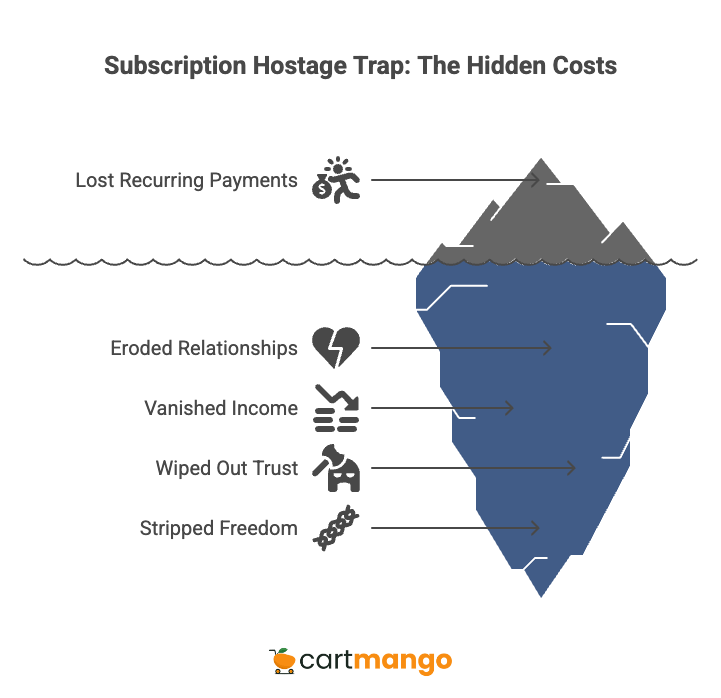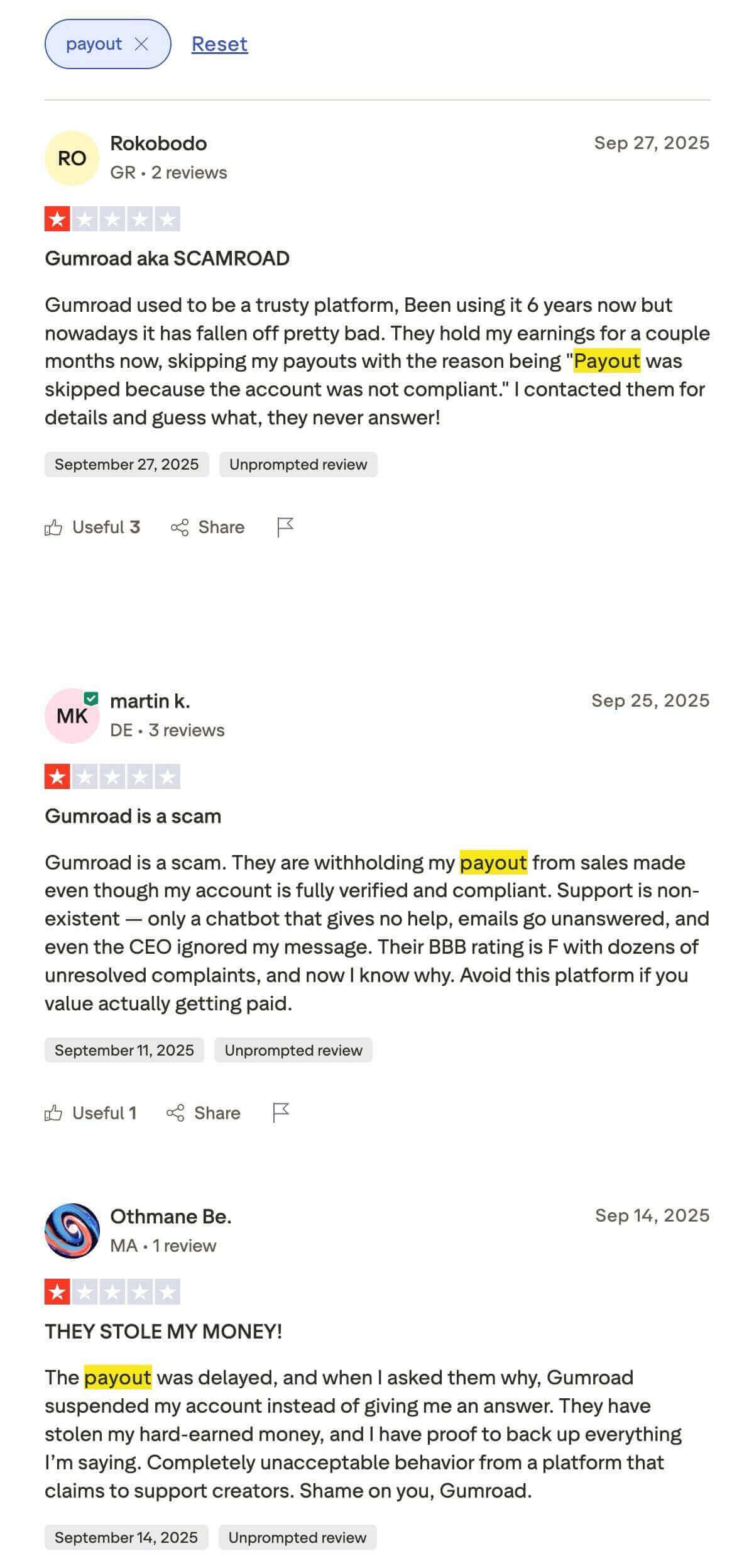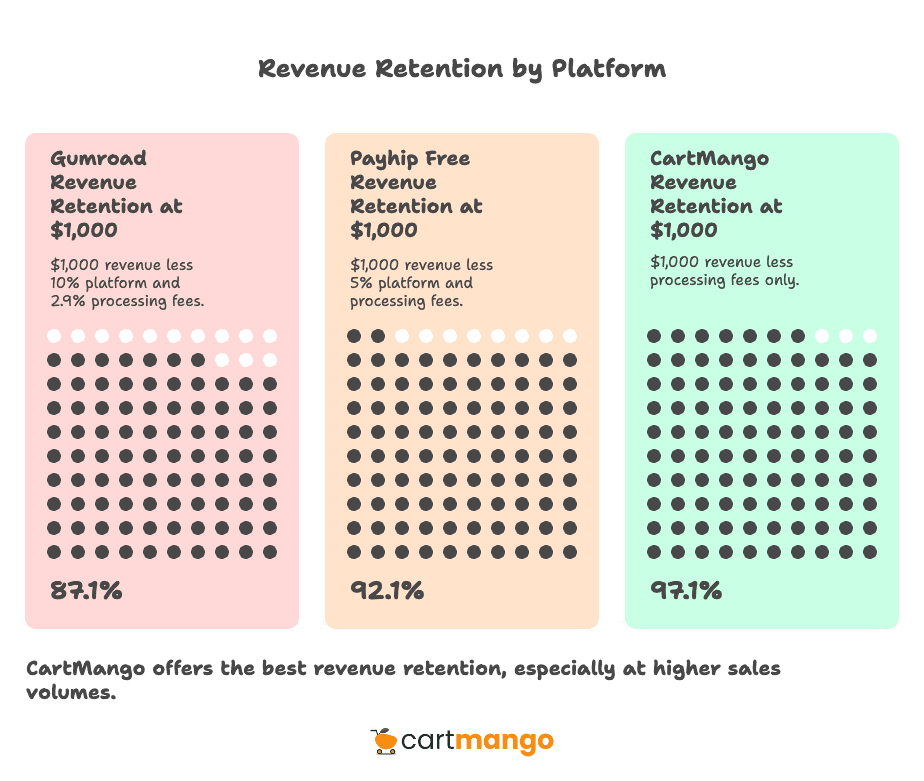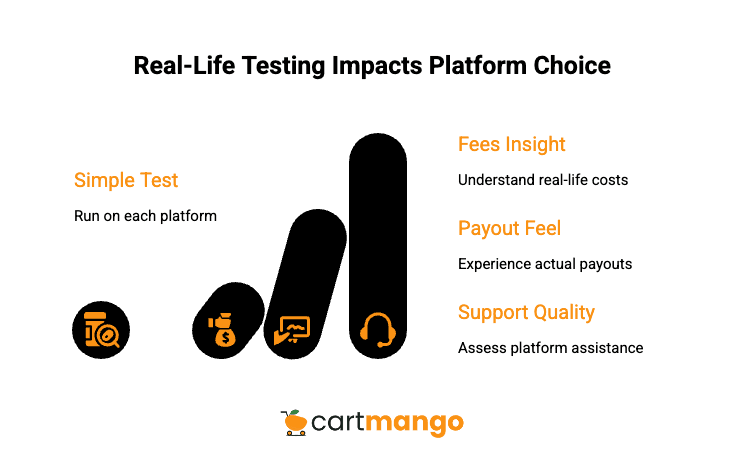You’ve built a business, stacked up customers, and feel confident. Then you discovered that leaving Gumroad or Payhip means losing all your recurring payments. This is the Gumroad vs Payhip comparison that tackles the core issue – your business freedom.
The Problem: Subscription Hostage Trap

That’s not a minor setback. It’s losing relationships you worked to build. It’s seeing your audience disappear, feeling cheated and powerless.
Some creators watch steady income vanish overnight. Suddenly, years of effort are gone. You’re left with nothing but regret and the need to rebuild from zero.
Trust is wiped out. Freedom gets stripped away. You’re forced to make tough decisions, never really owning what you’ve built.
Gumroad & Payhip Made Me Realize Something Was Broken – So We Build CartMango
Recurring payments shouldn’t vanish just because you switch platforms. My team and I saw creators lose years of work. Their loyal subscribers and steady income disappeared instantly.
We wanted a different solution. So, we built CartMango. It’s not about beating Gumroad or Payhip. Our approach puts your business and customers first. You keep the payments you work for, no matter what.
This comparison includes CartMango because it solves a real problem if you want control and freedom.
Gumroad vs Payhip vs CartMango
| Feature | Gumroad | Payhip | CartMango |
|---|---|---|---|
| Your recurring payments gone if you leave the platform? | ❌ Recurring payments lost if you leave | ❌ Recurring payments lost if you leave | ✅ You keep recurring payments |
| TOTALLY free? (note: Stripe / PayPal fees are standard across all cart platforms) | ❌ 10% + $0.50 per transaction | ❌ 5% per transaction (base plan). $29/mo + 2% (Plus plan). $99/mo (Pro plan). | ✅ Yes, 0 monthly fees, 0% commission. All features included (until 2027). |
| Customer support | ❌ Poor customer support & AI chatbots. Deleted feedback posts, ignored emails (source). | Responsive email support with generally positive user reviews, but live chat is not available. | Founder-led personal support, no chatbots, no live chat. Average response time is 1 hour+ |
| Buy now, pay later (BNPL) support for your customers (boost your sales) | ❌ No true BNPL: Gumroad’s installment plans pay you over time, not upfront. So you risk missed payments if customers bail before finishing what they owe. | ❌ No true BNPL: Payhip’s installment plans pay you over time, not upfront. So you risk missed payments if customers bail before finishing what they owe. | ✅ |
| Order bumps to boost sales | ✅ | ✅ | ✅ |
| Subscriptions (support trials & set up fees) | ✅ | ⚠️ Subscriptions only work with Stripe, not PayPal. So you can’t sell subscriptions if customers pay with PayPal. | ✅ |
| Dynamic coupons & discounts | ✅ | ✅ | ✅ |
| Optimized & fast checkouts | ✅ | ✅ | ✅ |
| Customers need NOT log in before buying (quick checkout experience) | ✅ | ✅ | ✅ |
| Direct, instant payout to your Stripe / PayPal (no withholding payments) | ❌ 7-day hold, but many sellers face much longer payout holds without clear explanation (source) | ✅ | ✅ |
| If download links are shared by rogue customers, will they work? | ✅ Links are protected | ✅ Links are protected | ✅ Links are protected |
| Funnels (upsells & downsells) | ⚠️ Supports upsells but no true conditional downsells | ❌ Does not support upsells / downsells | ❌ Coming soon |
| Integrations | ⚠️ Native integrations: Only Discord & Circle for instant community / membership access. For everything else, you’ll need Zapier. | ✅ Integrations with WordPress, Squarespace, Wix, Weebly, Shopify, Calendly, Zoom, Bookvault, AdSense, chat, mailing lists, and Zapier. | ⚠️ Limited native integrations, but its Make.com integration gives you access to 3,000+ apps. Current native integrations: Kit, ActiveCampaign, Beehiiv, and BirdSend, with more coming soon. |
| Affiliate management | ✅ | ✅ | ❌ Coming soon |
| Best for | Creators who want a fast, no-monthly-fee way to start selling and are willing to give up a huge 10% cut of revenue and live without advanced funnel tools or deep customization. | Creators who want simple global VAT handling and easy setup, but need to watch out for per-transaction fees that add up as sales grow. | Solo digital creators who want a simple, fast checkout tool that converts and currently don’t need bells & whistles. |
| Free migration | ❌ No free migration | ❌ No free migration | ✅ Free migration included |
These are the links for each platform: Gumroad, Payhip, CartMango.
CartMango: Not Necessarily Better, But Different
CartMango isn’t trying to be the ultimate checkout for every creator. It’s made for solo digital sellers who want simplicity without extra layers. If you just need clean, fast transactions that boost your income, CartMango does that.
No monthly fees until 2027. You don’t get charged commission per sale either. You still pay Stripe/PayPal fees directly to them, like all other cart platforms.
All features stay unlocked. You’re not stuck with basic tools waiting for an “upgrade” upsell.
You keep all your recurring payments if you ever leave. This means you don’t have to worry about your revenue stream vanishing. The platform gives you instant payouts to Stripe or PayPal. No unexplained holds or long waits.
Support is personal. My team and I answer questions and solves issues directly. No chatbots, no canned replies. Usually, responses come within an hour. Many users find this calming, though larger companies might need speedier options.
CartMango is built for small teams and solo digital creators. If you want advanced branding, deep design control, or complex funnels, this isn’t the place. Order bumps, subscriptions, and piracy protection come standard, but full upsells and affiliate features are still on the roadmap. For fast setup, worry-free migration, and simple selling, CartMango can be a good fit for you.
Gumroad Breakdown
Gumroad keeps setup simple for selling digital goods and memberships. The tradeoff is a huge 10% + 50 cents per sale. Stripe/PayPal fees apply on top of that, which applies to the other carts too. Fees are higher when sales come through Gumroad Discover, which is 30% per sale, but you get added exposure to their marketplace.
Payouts run on a weekly Friday schedule, and funds must sit in your balance for at least 7 days before they are eligible to be paid out. There are numerous user complaints about delayed and even withheld payouts.

Gumroad works for creators who want a no-frills start with basic product pages, simple subscriptions, and a built-in marketplace. The fee model can be fine at low volume, then it starts to bite as revenue climbs. If you need fast payouts, predictable fees, or full control over subscription portability, weigh those needs against the convenience you get here.
If you delete your account or leave the platform, all your recurring payments from customers stop, which means you face the same subscription hostage problem many creators now talk about in forums and reviews. Years of subscription revenue can disappear the moment you walk away.
Gumroad works best for smaller creators who care about simplicity and do not mind higher fees or reduced control over long term recurring income.
Payhip Breakdown
Payhip offers 3 pricing tiers for creators selling digital products and memberships:
- The base plan charges a 5% transaction fee with no monthly cost.
- Plus costs $29 per month + a 2% transaction fee
- Pro is $99 monthly with zero transaction fees.
Payment processor charges from Stripe or PayPal still apply on every plan, usually around 2.9 percent plus 30 cents per sale. Again, this is universal for all shopping carts.
One strong feature is automatic EU and UK VAT handling, where Payhip calculates, collects, and remits the correct tax for digital products.
You can host a simple storefront on Payhip or embed checkout buttons into your own website, and integrations cover tools like WordPress, Shopify, and major email providers. Support is handled by email and reviewers often describe it as friendly and reasonably quick, although there is no live chat option.
If you ever move your business away from Payhip, you lose access to those recurring subscription payments, which puts you in the same subscription hostage situation as many Gumroad sellers.
Subscriptions only work with Stripe, so customers who want to pay recurring fees with PayPal cannot do that on Payhip.
.
Pricing: Real Cost Over Time

- On Gumroad, you pay a 10% platform fee on each sale + card processing fees around 2.9% + $0.30 per transaction through Stripe or PayPal.
- Payhip’s Free plan charges 5% with no monthly cost, while the $29 and $99 plans lower or remove that fee, and all of them still add Stripe or PayPal charges.
- CartMango has no platform or subscription fees until at least 2027, so you only pay the usual processor cut.
At $1,000 in monthly revenue:
- Gumroad takes about 10% in platform fees plus roughly 2.9% in processing. You keep around $871. We didn’t even count the extra $0.50 Gumroad fee per sale.
- On Payhip Free, that same $1,000 sees 5% in platform fees and similar processor costs, so you keep about $921.
- With CartMango, you only pay the processor share, so you keep roughly $971 from that $1,000.
At $10,000 per month:
- Gumroad’s 10% platform cut is about $1,000 and a 2.9% processor share brings total fees close to $1,290.
- On Payhip Pro, you pay a flat $99 for the plan plus $290 in processing, so about $389 in total fees.
- With CartMango, you only cover the processor portion, $290 here, so more of that $10,000 stays in your account.
Support & Ease of Use
Gumroad
On ease of use, Gumroad keeps selling simple, since you just add a product, upload files, and publish. Problems often start when you need support. Trustpilot reviews talk about slow or missing replies, canned responses that feel like bots, and difficulty resolving account or payout issues, which leaves some creators feeling exposed when money or customer access is on the line.

Payhip
Payhip’s dashboard is straightforward, and many mention that setting up products or a small store feels clear even for non technical users. They get praise for fast, friendly replies and staff who follow through on questions or small migration problems. There are some unhappy cases, usually around disputes, but the overall pattern is positive.
CartMango
CartMango is smaller, so support works differently. The founder and small team reply directly, which means you talk to people who build and run the product. They also help migrate products and customers from other carts. For ease of use, CartMango focuses on quick product setup and a simple interface that any solo digital creator can instantly use.
.
These are the links for each platform: Gumroad, Payhip, CartMango.
Which Platform Fits What You Sell?
Digital downloads, ebooks, and templates
If you want to sell digital downloads such as an ebook, templates, or other small files, Gumroad, Payhip, and CartMango all cover that core use case.
CartMango keeps it simple for digital creators who just want to sell online with a direct link instead of a full online store. Payhip and Gumroad give you storefront pages, product grids, and collections.
CartMango focuses on an easy-to-use checkout that connects to your existing tools so you can use it to sell templates, files, or small offers without learning a big ecommerce system.
All 3 platforms offer marketing tools around the cart. Using Payhip, Gumroad, or CartMango, you can add coupons, run a discount code, and pair related items together so buyers see more than one offer when they buy products.
The mechanics differ a bit… from Payhip cross-sell features to Gumroad upsells and CartMango order bumps (upsells and downsells coming soon), yet the goal is the same. It’s to grow your average order value without needing a separate app.
Courses, communities, and selling internationally
For a course, membership, or online courses with recurring billing, you look less at surface design and more at subscription rules.
Gumroad and Payhip handle memberships, but subscriptions stop if you leave the platform, which can be a con if you plan to build full-time income around long running programs. CartMango keeps those subscriptions running even if you later move to a different platform.
If you are selling internationally and need help with taxes, Payhip takes care of EU and UK VAT inside the product settings. Gumroad and CartMango expect you to plug into external tax tools or work with an accountant, which is fine for some regions but extra work if you run a big audience across borders.
Physical products and all-in-one goals
If you also ship physical products alongside digital ones, Payhip’s store builder and product pages can cover both in one place. You treat it like a small ecommerce site, and customer service, checkout, and delivery all live inside a single login. Gumroad can handle simple physical items too.
CartMango is not trying to replace Etsy or large platforms for selling physical goods. It is a focused cart you use to sell digital products, courses, and subscriptions, and you connect other tools around it when you need extra functionality. If you want one central cart plus your own stack of marketing tools, CartMango becomes the alternative that fits that setup without locking you into a single all-in-one platform.
.
These are the links for each platform: Gumroad, Payhip, CartMango.
FAQs: Gumroad vs Payhip vs CartMango
Which platform is the most affordable?
At low revenue, Gumroad costs 10% per sale + Stripe / PayPal fees.
Payhip Free charges 5% plus the same processor cut, while its $99 Pro plan removes the platform fee.
CartMango charges $0 monthly + 0% platform fees until 2027, and you only pay processor costs.
At a few hundred dollars per month the gap is small, but past $1,000 CartMango and Payhip Pro usually leave you with more money than Gumroad.
Which is best for subscriptions and recurring revenue?
Gumroad and Payhip both handle subscriptions, but one catch is what happens if you leave.
When you close your account or move away, your recurring payments stop on those platforms, so you cannot keep charging those customers.
CartMango was created to avoid this; subscriptions continue through your own Stripe or PayPal setup, and you stay in control even if you move tools later.
Which feels easiest for a solo digital creator?
Gumroad is quick for uploading a single product and sharing a link.
Payhip takes longer to set up because of storefront design, VAT tools, and more settings, yet that control helps if you want a branded online shop.
CartMango keeps the dashboard light and focuses on 1-minute product setup, with the team helping you migrate if needed.
TL;DR
Choosing between Gumroad, Payhip, and CartMango starts with your revenue model. If you do not mind higher fees, Gumroad can be fine for a quick, simple setup.
If you want a hosted storefront, flexible plans, and automated VAT for EU and UK customers, Payhip fits better, especially when revenue grows to justify the $29 or $99 monthly plans that cut or remove the 5% fee.
If speed matters, it’s tough to beat CartMango’s 1-minute product setup. And if you also value recurring revenue and ownership, CartMango stands apart because your subscriptions keep running even if you leave, and there aren’t any platform fees at all until 2027.
If you are still unsure, pick 1 small product and run a simple test on each platform. Watch how fees, payouts, and support feel in real life instead of only on comparison pages like this.

Own your business. Skip the hype.
Be in control of your existing recurring payments and don’t let anyone take your livelihood away.
Set up your digital product in 60 seconds.
CartMango’s pricing is totally free: $0 monthly + 0% commission until 2027. You still need to pay Stripe/PayPal fees, as with all other carts.
Plus, you get founder-led support from day 1. No credit card.
These are the links for each platform: Gumroad, Payhip, CartMango.
Related Reading
- Gumroad vs Payhip: The Hidden Trap for Creators (2025)
- ThriveCart vs SamCart – The Subscription Hostage Trap (2025)
- 8 ThriveCart Alternatives & The Lifetime Pricing Paradox (2025)
- 8 SamCart alternatives + Subscription hostage (2025)
- The GENTLE Method: Soft marketing for creators
- How Far in Advance Should You Promote a Webinar?
- The SAVINGS Method: The Productivity Improvement Plan for Creators
- 9 Questions to Ask: How to Hire a Digital Marketing Agency
- Decision That Costs Millions? Marketing Funnel vs Customer Journey
- Audit Your Growth Funnels in 10 Minutes
